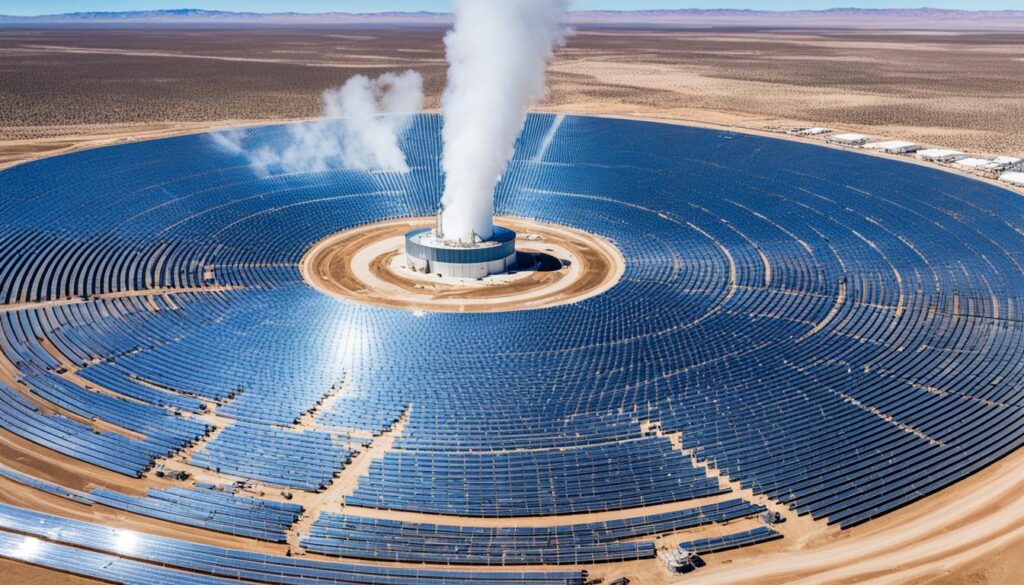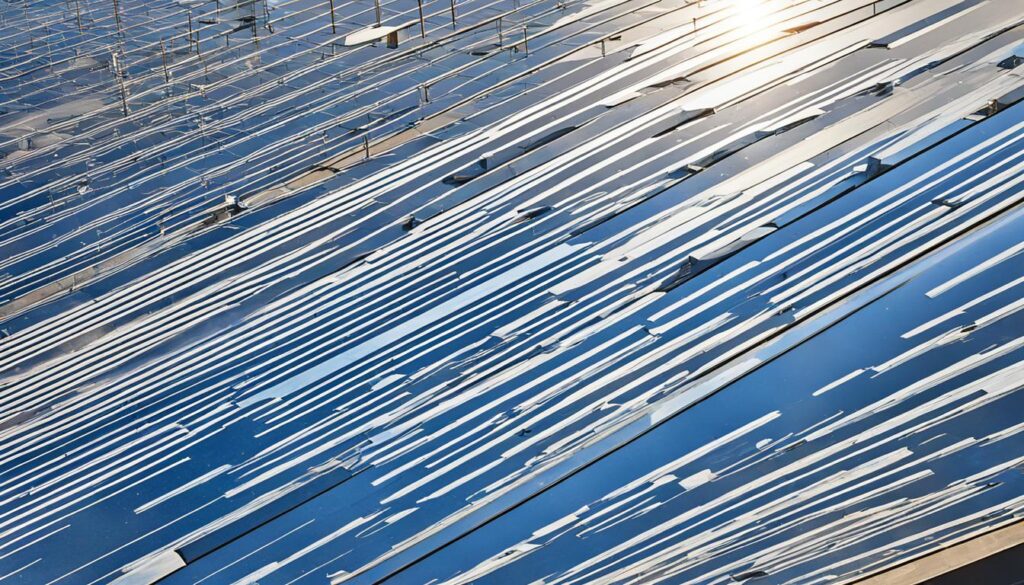Solar thermal-electric power systems use sunlight to make electricity. They collect and focus it to create high temperatures. These power plants work thanks to advanced technology. Each system has two important parts: reflectors that catch sunlight and a receiver.
A fluid in the receiver gets very hot. It becomes steam. This steam turns a turbine, which runs a generator to make electricity. Tracking systems help by moving the reflectors to follow the sun’s path. This keeps the system efficient all day.
These plants have big fields full of collectors. The collectors send heat to the turbine and generator. Many plants in the United States can work together. They show how well this kind of renewable energy can grow and change.
Key Takeaways
- Solar thermal-electric power systems use mirrors and lenses to concentrate sunlight and generate high temperatures for electricity production.
- These systems utilize heat-transfer fluids to produce steam, which drives turbines and generators to create renewable electricity.
- Solar thermal power plants often feature large arrays of collectors that track the sun’s movement to maximize energy capture.
- Multiple solar thermal power plants can be integrated at a single facility to increase overall electricity generation capacity.
- Solar thermal energy offers a reliable and scalable renewable power solution, complementing other clean energy technologies.
Understanding Solar Thermal Power Plants
Solar thermal power plants use the sun’s energy to make heat. This heat is then turned into electricity. They work differently than solar panels that change sunlight directly into power. Solar thermal systems focus sunlight using mirrors or lenses to heat up water.
Working Principle of Solar Thermal Systems
Solar thermal systems turn the sun’s heat into power. This happens when solar radiation is converted into thermal energy. Then, a fluid is heated, like water or molten salt. This hot fluid moves a turbine to produce electricity. It can store heat, which means it can make power even when it’s cloudy.
Components of a Solar Thermal Power Plant
A solar thermal power plant has key parts like solar collectors and heat transfer fluid. It also has a way to turn heat into electricity and thermal energy storage. The collectors focus sunlight to heat the transfer fluid. This fluid then creates steam. The steam powers a turbine that makes electricity. With thermal energy storage, the plant can make power even without direct sunlight.

Types of solar thermal power plant
The solar thermal power industry has many technologies, each with unique benefits. These systems use the sun’s energy to create electricity. Now, let’s look at the different kinds of solar thermal power plants:
Linear Concentrating Systems
Linear concentrating systems include parabolic trough systems and linear Fresnel reflectors. They have long, curved mirrors that focus sunlight onto a receiver tube. This tube runs along the mirrors. The heat it gathers is used to create steam, which turns a turbine to make electricity.
Parabolic Trough Systems
Among concentrated solar power types, parabolic trough systems are the most common. They use mirror-lined troughs to direct sunlight to a receiver tube. Inside this tube is a fluid that heats up. It’s this fluid that creates steam, turning a turbine to produce power.
Linear Fresnel Reflectors
Linear Fresnel reflectors have flat, long mirrors that direct sunlight onto receiver tubes. This method is more affordable than parabolic troughs. That’s why it’s a good choice for large solar power projects.
Solar Power Towers
Solar power towers work by reflecting sunlight onto a central receiver at the top of a tower. This is done by a field of mirrors called heliostats. The heat is then used to make steam, which powers a turbine for electricity.
Solar Dish/Engines
Solar dish/engine systems use a big, dish-shaped mirror to concentrate sunlight onto a receiver. This receiver has a Stirling engine. The engine turns the heat into electricity.
Conclusion
The solar thermal power industry has grown a lot in recent years. New tech and lower costs have made these clean energy systems more popular. They use different technologies like parabolic troughs, solar towers, and dish/engine systems to create electricity without pollution.
These power tower systems work by capturing the sun’s heat and turning it into energy. They’ve gotten better with the use of molten salt technology. This improvement helps keep the power supply stable, which is great for meeting both big and small energy needs.
As more people look for clean energy options, solar thermal power is becoming key for India’s energy future. By investing in new tech and ideas, this industry will keep growing. It promises a future where India relies more on sustainable energy, making the country safer and greener.
FAQ
What is a solar thermal power plant?
A solar thermal power plant captures sunlight to make electricity. It does this by using mirrors or lenses to focus sunlight onto a receiver. This heats a fluid that drives turbines to produce electricity.
How do solar thermal power systems work?
Solar thermal power systems work through two main parts. First, there are reflectors that collect and focus the sunlight. Then, a receiver heats a fluid which creates steam. This steam powers a turbine, generating electricity.
What are the different types of solar thermal power plant technologies?
Various solar thermal power plant technologies exist. Examples are parabolic troughs, linear Fresnel reflectors, solar power towers, and solar dish/engine systems. They each have unique ways to gather and concentrate sunlight.
What are the advantages of solar thermal power?
The key benefit is that solar thermal power can store heat for later use. This means it can make electricity when the sun is not out. It doesn’t require a separate storage system like other solar energy types.
How is solar resource assessment conducted for solar thermal power plants?
Assessing the solar resource assessment. is vital in planning solar thermal power plants. It includes looking at solar radiation, climate, and other weather data. This helps pick the best spot and design for the plant.

